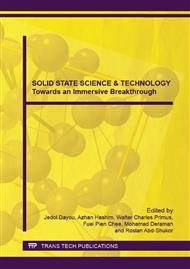p.236
p.242
p.247
p.255
p.261
p.267
p.272
p.278
p.283
Influence of Molar Ratio of Citric Acid to Metal Ions on Structure, Microstructure and Electrical Transport Properties on Nanosized La0.85Na0.15MnO3
Abstract:
In this paper, nanosized La0.85Na0.15MnO3 (LNMO) has been synthesized via sol-gel method by involving two major steps, first the complexation of citric acid (CA) with metal ions (MI) and second the polyesterification between CA and ethylene glycol (EG). The effect of molar ratio CA:MI varying from 2-4 on structure, microstructure and electrical transport properties of LNMO have been investigated by constant the amount of EG. All samples show single perovskite phase with hexagonal structure and space group R3c after sintering at 800°C for 10h. Sample of molar ratio 2.5 is observed to possess smallest grain sizes which yield high resistivity value compared with others, is suggested to originate from the increase of tunneling barriers (grain boundaries). The large low field magnetoresistance (LFMR) of about ~ -16% at 0.1T and low temperature confirmed the important role of grain boundaries in the nanosized LNMO.
Info:
Periodical:
Pages:
261-266
Citation:
Online since:
June 2015
Keywords:
Price:
Сopyright:
© 2015 Trans Tech Publications Ltd. All Rights Reserved
Share:
Citation:


